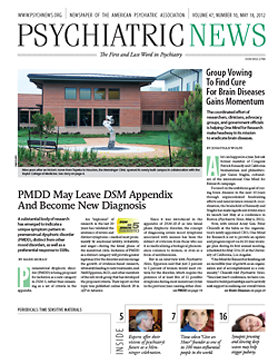Psychiatrist and neuroscientist Solomon Snyder, M.D., is renowned both for the many discoveries that have emerged from his lab over four decades and for a bold approach to doing science.
Over 40 years, his laboratory at Johns Hopkins produced new insights into the neurobiology of psychiatric disorders, illuminating pathways to new treatments.
His work encompasses basic research that changed clinical thinking, said former APA President Carolyn Robinowitz, M.D., who has known Snyder since their medical school days. “He thinks not just about disease but about how the entire physiology of the body functions.”
Both the productivity and the daring may be a mixture of nature and nurture—his parents first, and then a Nobel-winning scientific mentor at the National Institutes of Health.
Snyder’s father worked in Washington, D.C., in the 1930s at the precursor to what is now the National Security Agency studying secret codes and how to break them. He was one of the first people to adapt computers to code breaking, and he taught a 10-year-old Sol how to program in machine language.
“My father had gone to night school, valued education, and imbued me with a love for science,” recalled Snyder in a recent interview.
His mother had an entrepreneurial streak, starting a club for out-of-towners who moved to Washington, D.C., during World War II and adding to the family income by entering the puzzle contests that advertisers used to run.
During college at Georgetown University, he earned money by giving guitar lessons (and briefly contemplated a career in music). One student was a doctor, a research associate at the National Institutes of Health, who offered Snyder a lab technician’s job for the summer before he started Georgetown University Medical School in 1958.
That experience, after a year of internship at Kaiser Foundation Hospital in San Francisco, led to two crucial years as a research associate at the National Institute of Mental Health (NIMH).
Embracing the ‘Audacity of Science’
Crucial, because at NIMH he was nurtured by Julius Axelrod, Ph.D., who would share the Nobel Prize in 1970 for his work on the reuptake of neurotransmitters by the presynaptic nerve ending. Axelrod’s working style in the laboratory embraced a willingness to take chances to make large gains in knowledge.
Snyder calls the approach the “audacity of science.”
“Axelrod exemplified the importance of combining some scientific knowledge with original ideas, of thinking off the wall,” he said. “Creativity in science is the willingness to try things that seem ridiculously far out and go for it no matter what—not worrying about the consequences, just pursuing your own curiosity.”
In 1965, Snyder moved to Johns Hopkins and began a psychiatry residency. A year later he was named an assistant professor of pharmacology and experimental therapeutics and in 1970, at age 31, a full professor in that department and in psychiatry.
The work he began in those years and that continues today—Snyder has published more than 1,000 papers and half a dozen books—can be broadly placed under the umbrella of “molecular neuroscience.”
An early landmark came in 1973 with a publication, cowritten with Candace Pet, Ph.D., that identified and characterized the opiate receptor. Since then, Snyder and his many collaborators have also studied the role of enkephalins, dopamine receptors, and inositol phosphates and introduced the idea of a gas—nitric oxide—as a neurotransmitter.
“He has been a giant in the field in characterizing the diversity of neurotransmitters,” said Joseph Coyle, M.D., a professor of psychiatry and neuroscience at Harvard Medical School. Coyle worked for Snyder during medical school and later was a faculty colleague at Hopkins.
Snyder knew that receptor binding was a very important way of understanding neural communication, said Coyle in an interview. The techniques for studying these mechanisms might seem simple now, but nobody before him could get it right, he said. Snyder eventually characterized many ways that neurons talk to each other.
Snyder founded Hopkins’ Department of Neuroscience in 1980; it was named after him in 2006.
Today, there is a close relationship between the departments of neuroscience and psychiatry at Hopkins, said psychiatry chair Raymond DePaulo, M.D.
“Perhaps 15 percent of the psychiatry faculty has trained in the neuroscience department, most of them with Sol,” said DePaulo in an interview. “He cares deeply and passionately about the mentally ill.”
A Master at Connecting the Dots
Coyle and many others quickly came to appreciate Snyder’s style as a scientist and as a lab director.
“Sol is a clinically trained scientist who can ask fundamental questions but can connect the dots between basic findings and clinical relevance,” said Coyle.
“He was a master at designing the most efficient experiment to get the answer,” said Anne Young, M.D., Ph.D., a professor of neurology at Harvard Medical School and chief of neurology at Massachusetts General Hospital. Forty years ago she worked in Snyder’s lab during medical school.
“I’d show him a cool experiment intended to get some information, and he’d give me an alternative,” she told Psychiatric News.
It wasn’t just designing experiments. Snyder taught his students how to evaluate results and write them up for publication, said Young. At first, he would invite them into his office and dictate the first drafts of papers himself. Soon, though, the students talked out those drafts under his supervision. Eventually, they learned how to prepare their own papers and present them for Snyder’s final review.
“I like to do with researchers what Sol has done in his lab,” said Young. “I like to give students the room to do new things so that they really own them and not just give them jobs to do.”
Snyder is a psychiatrist, which may explain why he is better at motivating people than she is, said Young.
“He figured out that some people worked much harder if they were punished, and other people worked harder if they were patted on the back,” Young said.
Snyder’s broad interests contribute to his research, said Young. “He reads about cardiology, gastroenterology, or some other field and then brings those insights back to the nervous system,” she said.
“The more things we know, the more things come together, as in the common genetic programs that underlie cell death, for instance,” Snyder said. “In oncology, research on cell death is important because you want to kill cancer cells. In neuroscience, it’s equally important because you want to block neurons from dying.”
So he pays a lot of attention these days to research on oncogenes and tumor suppressors because of their relationship to the nervous system.
Beyond his own lab’s output, Snyder has served as a mentor to hundreds of younger scientists and physicians, who are nurturing yet another scientific generation, just as Axelrod guided Snyder early on.
“He has trained an incredible number of people who have gone on to be leading researchers in pharmacology, psychiatry, neurology, and basic neuroscience,” said Coyle.
“Sol is a visionary and inspirational scientist who has made fundamental advances in so many areas of neuroscience relevant to psychiatry that his contributions are difficult to capture briefly,” summed up John Krystal, M.D., editor of Biological Psychiatry and chair of the Department of Psychiatry at Yale University School of Medicine.
His life is hardly restricted to the lab, however. He still plays the guitar and serves on the boards of the Baltimore Symphony Orchestra and the Peabody Institute, the conservatory that is part of Johns Hopkins.
At 73, asked if he thinks about retirement, Snyder answered, “Maybe in 30 years.”
He might make it. In any case, the stream of papers, postdocs, and students issuing from his lab is unlikely to slow down anytime soon.



